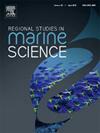Ecological status and resilience of coral reefs in South-Central Vietnam (Khanh Hoa Province) in the third decade of the 21st century
IF 2.1
4区 环境科学与生态学
Q3 ECOLOGY
引用次数: 0
Abstract
Khanh Hoa Province of South-Central Vietnam has extended coastline with many bays, coves and islands, which historically formed favorable conditions for the development of coral reefs in the South China Sea. The area is characterized by a high diversity of reef-building corals (more than 350 species). However, since the beginning of the 2000s, local coral communities have been in a state of increasing decline resulting from the enhancement of stressful natural and anthropogenic impacts. During the 3-year period (2022–2024), a complex assessment of coral reef status and a number of stressful factors has been performed on 17 reef sites in the coastal waters of the province. The mean coral cover was 27.4 % ± SD 26.8 %; coral taxa with stress-tolerant and weedy life strategies made the largest contributions to the composition of local coral communities. Only 5 of 17 sites revealed relatively high cover (>50 %), and only 7 sites had a coral genus richness > 10. More than half of the sites (9) revealed a high proportion of coral rubble (>20 %) as an obvious sign of reef decline. The phase shift from the dominance of stony corals to the dominance of macroalgae or non-skeleton cnidarians (soft coral Clavularia sp. and corallimorpharians Rhodactis spp.) was observed at 7 sites. Five stressful environmental factors stipulating reef decline were distinguished: 1) impact of annual cyclones; 2) anthropogenic reinforcement of sedimentation and eutrophication; 3) overfishing; 4) repetitive crown-of-thorns starfish outbreaks; and 5) sea surface temperature anomalies (the latter is mitigated by seasonal upwelling). Of the 17 reef sites, 2 with high resilience potential were recommended marine-protected areas. The management of other sites should be improved to increase reef resilience and biodiversity conservation.
求助全文
约1分钟内获得全文
求助全文
来源期刊

Regional Studies in Marine Science
Agricultural and Biological Sciences-Ecology, Evolution, Behavior and Systematics
CiteScore
3.90
自引率
4.80%
发文量
336
审稿时长
69 days
期刊介绍:
REGIONAL STUDIES IN MARINE SCIENCE will publish scientifically sound papers on regional aspects of maritime and marine resources in estuaries, coastal zones, continental shelf, the seas and oceans.
 求助内容:
求助内容: 应助结果提醒方式:
应助结果提醒方式:


